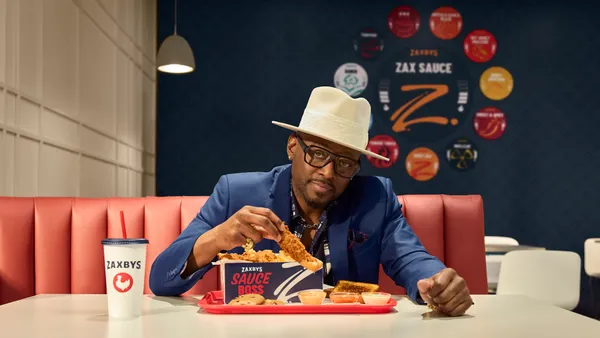Dive Brief:
- Popeyes will bring back its fried chicken sandwich on Sunday, Nov. 3, according to an announcement. The offering previously sold out within weeks of its Aug. 12 debut.
- In a video attached to the news, a person posts an "Open Sunday" tag under a Popeyes roadside advertisement. The Popeyes ad sits directly next to one for Chick-fil-A that notes the rival is closed on Sundays.
- A tweet posted on Popeyes' official Twitter account said the menu item will be back, not just on Nov. 3, but also "every day" moving forward, indicating the return is permanent. Popeyes previously said that this would be the case.
Dive Insight:
With a shot across the bow at Chick-fil-A, Popeyes continues a viral marketing spat that many have dubbed the chicken sandwich wars, echoing the notorious Coke-Pepsi Cola Wars of the '80s.
Y’all…the sandwich is back Sunday, November 3rd. Then every day. ???????? pic.twitter.com/JDxyCIv0zz
— Popeyes Chicken (@PopeyesChicken) October 28, 2019
The timing of the chicken sandwich's return is deliberate: Restaurant Brands International (RBI), the owner of Popeyes, reported the chain's comparable sales rose 9.7% overall in Q3 earnings released Monday.
"Popeyes had one of its best quarters in nearly two decades, achieving comparable sales growth of more than 10% in the US," Jose Cil, CEO at RBI, said in a press statement.
Popeyes' chicken sandwich is notable not just for its popularity — the chain plowed through two months' worth of supply in two weeks, per the International Business Times — but how little paid marketing the brand put behind the launch.
The company introduced the menu item with a stunt involving a Los Angeles restaurant that was previously called out for passing off the fast food purveyor's fried chicken as its own. But most of the traction for the sandwich was organic, spurred by online niches and people interested in seeing how the offering stacks up to category stalwart Chick-fil-A.
"What Popeyes did is they completely leveraged the power of a unique community [in] #BlackTwitter," JP Maheu, VP of U.S. client services at Twitter, said at Advertising Week New York this fall. "[Popeyes] actually didn't spend much money on Twitter. They leveraged their audience from an organic standpoint."
Maheu suggested the chain saw around $65 million in earned media for the sandwich's launch period. In the earnings report, RBI executives affirmed the brand generated millions in free media due to online buzz.
As supplies ran short, Popeyes continued to lean into community-led marketing to extend the conversation around its new hit. A few weeks after the official announcement of a sell-out on Aug. 27, the company encouraged customers to bring their own bun — a spin on "bring your own bottle," or BYOB — to recreate the chicken sandwich on their own.
Popeyes' success stands in contrast to other fast food brands that are deploying pricy, complex marketing stunts to draw consumer interest. White Claw, a spiked seltzer brand, has been a strikingly similar case study this year in how quality product and word of mouth can outperform heavy paid media investment. The Mark Anthony Brands-owned label commands 54% of the market, according to Nielsen, but a recent Kantar analysis indicates it has cut media spending by 30% in the past seven months amid product shortages.















